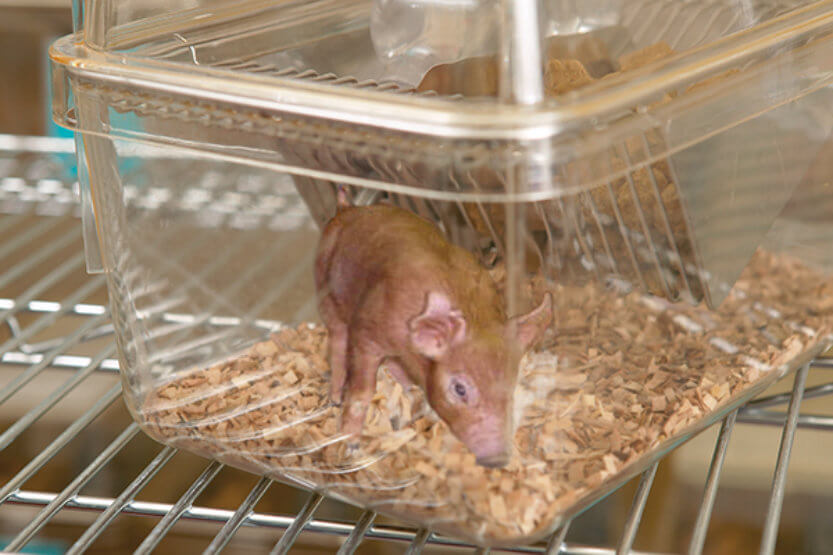Ingenious: Mapping the pig genome
 The pig genome is useful in screening cancer drugs. “Drug metabolism in pigs is very similar, if not identical, to what you see in humans,” says Professor Lawrence Schook. (Image by Lauretta Round)
The pig genome is useful in screening cancer drugs. “Drug metabolism in pigs is very similar, if not identical, to what you see in humans,” says Professor Lawrence Schook. (Image by Lauretta Round) When it was announced in 2001 that the University of Illinois would lead the first efforts to sequence the pig genome, Animal Sciences Professor Lawrence Schook had a lab party to celebrate. His team then started kicking around ideas about what to name the nine female piglets that had been cloned specifically for the gene-sequencing project.
“The names were all Disney characters,” Schook recalls. “We had Tinker Bell, Jasmine, Tiana, Aurora, Belle, Ariel, Snow White, Cinderella and Olivia.”
Schook decided to take the first letter of all nine names to spell out “TJ Tabasco,” rechristening the pig from which the piglets were cloned. Her DNA would be mapped and then used by researchers around the world.
The International Swine Genome Sequencing Consortium, chaired by Schook, began mapping the genome of TJ Tabasco in 2003 and completed its work in 2012. Today, TJ’s genetic material continues to be used worldwide, helping scientists achieve breakthroughs in agricultural and biomedical research.
Although Schook and the University of Illinois led the pig genome project, it was a global effort that drew on resources from labs in Denmark, England, France, Japan, Korea and Scotland. But before the project even got off the ground, there was fierce competition over whose pig would be chosen.
“Illinois was going up against a French sequencing center, started by a Nobel Prize winner, as well as the Sanger Centre in England, again with Nobel Prize winners,” Schook says. “But we held our own. Trust me.”
Ultimately, the consortium selected a young female Duroc pig named Cindy who was born on the U of I’s South Farms on Jan. 11, 2001. Schook came up with the idea of cloning Cindy and renaming her TJ Tabasco. Illinois animal scientists Jonathan Beever, ’86 ACES, MS ’89 ACES, PHD ’96 ACES, and Matt Wheeler assisted in the cloning, as well as Chris Wright and Alvaro Hernandez, PHD ’01 ACES, at the University’s Roy J. Carver Biotechnology Center.
Because of the genetic similarities between pigs and humans, TJ’s genome has been used in many types of biomedical research, including work on cystic fibrosis and xenotransplantation—the grafting or transplanting of organs, such as kidneys and hearts, between species. In this case, scientists hope to genetically alter pig organs to make them suitable for transplanting in humans, helping to address the shortage of transplant organs.
The pig genome also supports cancer research, a major focus of Schook’s lab. “Drug metabolism in pigs is very similar, if not identical, to what you see in humans,” he says. As a result, researchers in his lab have found ways to screen cancer drugs in the cell lines of pig tumors, shedding light on how the drugs might affect human tumors.
Porcine DNA benefits go beyond medicine, however. The agriculture industry has used the pig genome to discover ways to develop disease-resistant pigs, and the genome has even been used to trace how domesticated pigs descended from the wild boars that once roamed Europe and Eurasia.
Most recently, researchers from around the world resequenced TJ Tabasco’s genome using the latest long-range sequencing technology, with the results published in September 2020.
“So we’re still distributing her DNA,” Schook says. “We’re still sending samples all over the world.”

